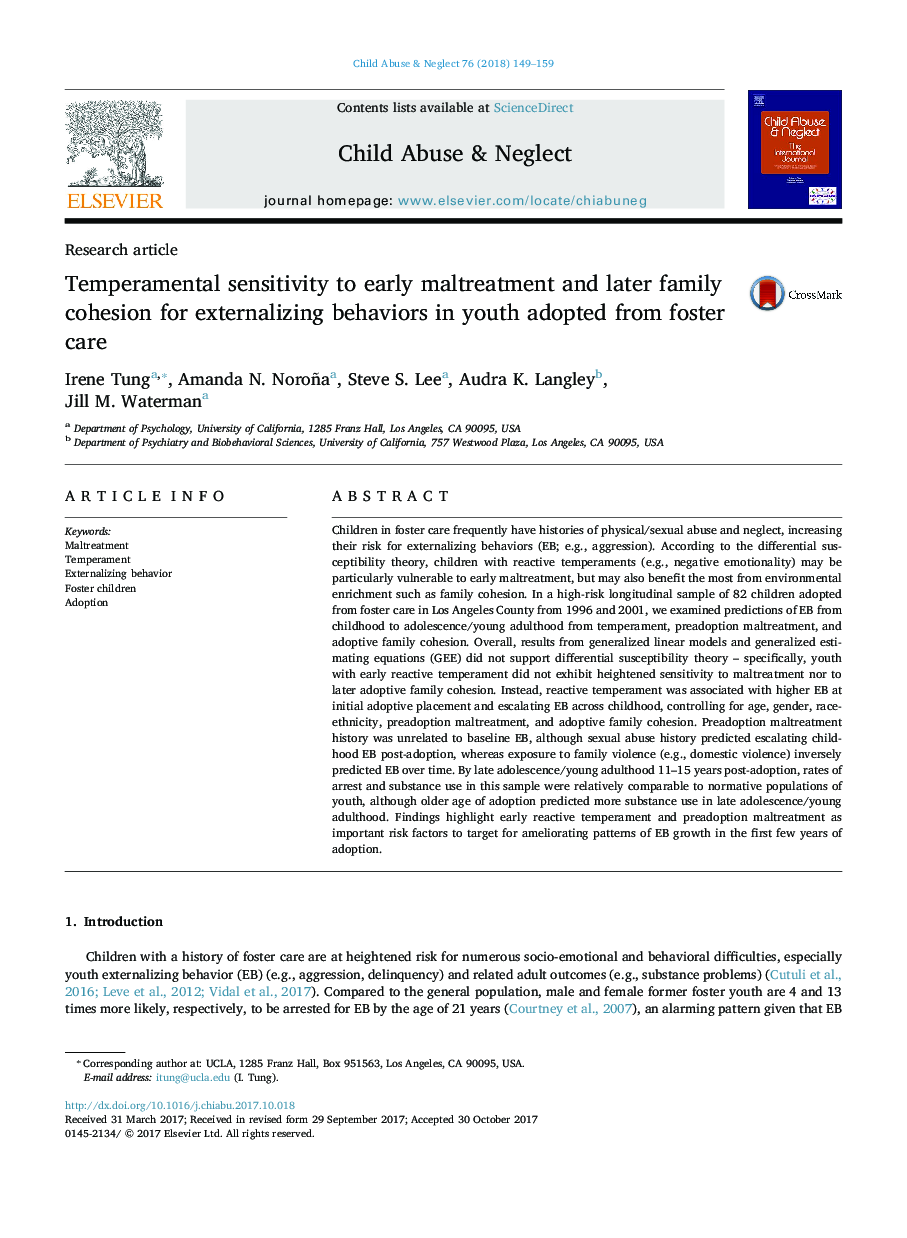| کد مقاله | کد نشریه | سال انتشار | مقاله انگلیسی | نسخه تمام متن |
|---|---|---|---|---|
| 6832116 | 1434352 | 2018 | 11 صفحه PDF | دانلود رایگان |
عنوان انگلیسی مقاله ISI
Temperamental sensitivity to early maltreatment and later family cohesion for externalizing behaviors in youth adopted from foster care
ترجمه فارسی عنوان
حساسیت شدید به مالت زودهنگام و پس از آن، انسجام خانوادگی برای رفتارهای خارجی در جوانان که از مراقبت های پرستاری گرفته شده است
دانلود مقاله + سفارش ترجمه
دانلود مقاله ISI انگلیسی
رایگان برای ایرانیان
کلمات کلیدی
بدرفتاری دماسنج، رفتار بیرونی، فرزندان فاستر، تصویب،
موضوعات مرتبط
علوم پزشکی و سلامت
پزشکی و دندانپزشکی
پریناتولوژی (پزشکی مادر و جنین)، طب اطفال و بهداشت کودک
چکیده انگلیسی
Children in foster care frequently have histories of physical/sexual abuse and neglect, increasing their risk for externalizing behaviors (EB; e.g., aggression). According to the differential susceptibility theory, children with reactive temperaments (e.g., negative emotionality) may be particularly vulnerable to early maltreatment, but may also benefit the most from environmental enrichment such as family cohesion. In a high-risk longitudinal sample of 82 children adopted from foster care in Los Angeles County from 1996 and 2001, we examined predictions of EB from childhood to adolescence/young adulthood from temperament, preadoption maltreatment, and adoptive family cohesion. Overall, results from generalized linear models and generalized estimating equations (GEE) did not support differential susceptibility theory - specifically, youth with early reactive temperament did not exhibit heightened sensitivity to maltreatment nor to later adoptive family cohesion. Instead, reactive temperament was associated with higher EB at initial adoptive placement and escalating EB across childhood, controlling for age, gender, race-ethnicity, preadoption maltreatment, and adoptive family cohesion. Preadoption maltreatment history was unrelated to baseline EB, although sexual abuse history predicted escalating childhood EB post-adoption, whereas exposure to family violence (e.g., domestic violence) inversely predicted EB over time. By late adolescence/young adulthood 11-15 years post-adoption, rates of arrest and substance use in this sample were relatively comparable to normative populations of youth, although older age of adoption predicted more substance use in late adolescence/young adulthood. Findings highlight early reactive temperament and preadoption maltreatment as important risk factors to target for ameliorating patterns of EB growth in the first few years of adoption.
ناشر
Database: Elsevier - ScienceDirect (ساینس دایرکت)
Journal: Child Abuse & Neglect - Volume 76, February 2018, Pages 149-159
Journal: Child Abuse & Neglect - Volume 76, February 2018, Pages 149-159
نویسندگان
Irene Tung, Amanda N. Noroña, Steve S. Lee, Audra K. Langley, Jill M. Waterman,
